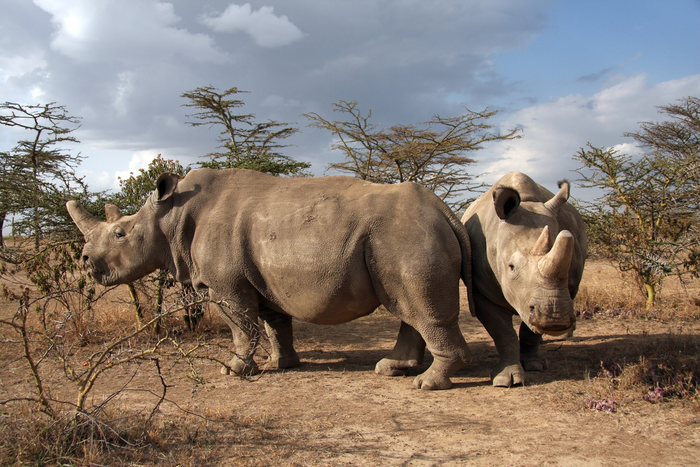The BioRescue Project is a research initiative to save the northern white rhinoceros from extinction. The subspecies is critically endangered, with only two individuals remaining alive. Both individuals are females, making it impossible for the species to continue reproducing naturally. To save the species, the BioRescue team has been working on creating lab-grown egg and sperm cells from the rhinos' stem cells.
The team recently reported a major milestone in their efforts, as they have successfully generated primordial germ cells from the stem cells, marking the first time this has ever been achieved. While there is still much work to be done, the BioRescue team is hopeful that their efforts will help save the northern white rhinoceros from extinction.
The BioRescue project, coordinated by the Leibniz Institute for Zoo and Wildlife Research, is working to save the northern white rhino from extinction. The project has been funded by the German Federal Ministry of Education and Research since 2019 and employs two strategies to achieve its goal.
One of these strategies involves generating viable sperm and eggs from the skin cells of deceased northern white rhinos. These cells then create embryos implanted into closely related southern white rhino females as surrogates. Through this process, the northern white rhino subspecies, which have been nearly wiped out by poaching, may be saved with the help of advanced stem cell and reproductive technologies.
Removing From Extinction Edge
The process of creating viable sperm and eggs from the skin cells of deceased northern white rhinos is not without precedent. Professor Katsuhiko Hayashi, a co-last author of the study, has successfully accomplished this feat using mice in his research labs at the Japanese universities of Osaka and Kyushu in Fukuoka. However, each new species presents its challenges. In this case, Hayashi is working closely with Dr. Sebastian Diecke and Professor Thomas Hildebrandt from the Max Delbrück Center and Leibniz-IZW, respectively, to adapt the technique for the northern white rhino. Both Diecke and Hildebrandt are co-last authors of the study.
According to the study's first author, Masafumi Hayashi of Osaka University, this is the first time primordial germ cells have been successfully generated from stem cells in a large, endangered mammalian species. Previously, this has only been achieved in rodents and primates. In the case of the northern white rhino, the researchers identified the SOX17 gene as being crucial for inducing PGCs. The SOX17 gene also plays a vital role in developing human germ cells and may do so in many other mammalian species.
The southern white rhino embryonic stem cells used in the study were grown by Professor Cesare Galli's team at the Avantea laboratory in Cremona, Italy. On the other hand, the northern white rhino PGCs were derived from the skin cells of Fatu's aunt, Nabire, who died in 2015 at the Safari Park Dvůr Králové in the Czech Republic. Diecke's team at the Max Delbrück Center then converted these cells into induced pluripotent stem cells.

ALSO READ: Northern White Rhinos Are Facing the Threat of Extinction, But Researchers Offer Good News
Primordial Germ Cells Maturation
According to Masafumi Hayashi, researchers hope to use the stem cell technology from Katsuhiko Hayashi's lab to save other endangered rhino species. There are five rhino species, almost all of which are classified as threatened on the IUCN Red List. In addition to generating PGCs for the northern white rhino, the team also used stem cells to grow PGCs for the southern white rhino, with a global population of around 20,000 individuals.
The researchers also identified two specific markers, CD9 and ITGA6, expressed on the surface of the progenitor cells of both white rhino subspecies. Hayashi said these markers would be useful for detecting and isolating PGCs from a group of pluripotent stem cells.
The next challenge for the BioRescue team is to mature the PGCs in the laboratory into functional egg and sperm cells. The primordial cells are relatively small compared to mature germ cells and, most importantly, still have a double set of chromosomes, as said by Dr. Vera Zywitza from Diecke's research group, who was also involved in the study. They, therefore, have to find suitable conditions under which the cells will grow and divide their chromosome set in half.
Key Conservation: Genetic Variation
Leibniz-IZW researcher Hildebrandt is pursuing a complementary strategy to save the northern white rhino. He plans to obtain egg cells from 22-year-old Fatu and fertilize them using frozen sperm collected from four deceased northern white rhino bulls. This process, known as intracytoplasmic sperm injection (ICSI), would be carried out in Galli's lab in Italy. However, Hildebrandt explains that Fatu cannot carry her offspring due to problems with her Achilles tendons.
Her mother, Najin, is also past child-bearing age and suffers from ovarian tumors. And in any case, since the team only has one donor of natural eggs left, the genetic variation of any resulting offspring would be too small to create a viable population, he adds.
The team's top priority is turning their PGCs into egg cells. In mice, they found that the presence of ovarian tissue was important in this crucial step, as said by Zywitza.
Since the scientists cannot simply extract this tissue from the two female rhinos, they will probably have to grow this from stem cells. Zywitza is hopeful that ovarian tissue from horses, among the rhinos' closest living relatives from an evolutionary standpoint, could be useful in this process. If humans had taken better care of wild rhinos, the BioRescue team's current challenge might have been avoided altogether.
RELATED ARTICLE : One of the World's Last Two Northern White Rhinos Retires From Breeding Project Due to Old Age, Illness
Check out more news and information on Northern White Rhino in Science Times.












